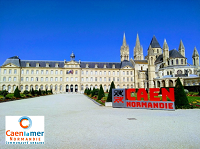Orateur
Description
Loosely bound nuclei are currently at the center of interest in low-energy nuclear physics. The deeper understanding of their properties provided by the shell model for open quantum systems changes the comprehension of many phenomena and offers new horizons for spectroscopic studies of nuclei from the driplines to the valley of $\beta$-stability, for states in the vicinity and above the first particle emission threshold [1,2]. Systematic studies in this broad region of masses and excitation energies will extend and complete our knowledge of atomic nuclei at the edge of stability.
In this talk, I will briefly review the recent progress in open quantum system shell model description of nuclear states and their decays. I will discuss the nature of the proton-decaying $0^+_2$ resonance of $\alpha$ particle [3], and the chameleon properties of near-threshold resonances due to the alignment of their wave functions with the decay channel, leading to the emergence of clusters [4]. The quantum nature of clustering in this regime will be illustrated on chosen examples of the chameleon nature of near-threshold resonances, and the systematic appearance of near-threshold resonances.
In the next step I will briefly comment on the evolution from the purely quantum regime of clustering at the edge of nuclear stability with respect to the particle emission, to the semi-classical mechanism at higher excitation energies and, finally, to the classical statistical clustering mechanism at the Fermi energy domain and above which is rooted in the Central Limit Theorem of Mathematics.
[1] N. Michel, M. Ploszajczak, Gamow Shell Model - The
Unified Theory of Nuclear Structure and Reactions, Lecture Notes in Physics 983 (Springer, Cham, 2021).
[2] N. Michel, W. Nazarewicz, M. Ploszajczak and T. Vertse, J. Phys. G: Nucl. Part. Phys., 36 (2008) 013101.
[3] N. Michel, W. Nazarewicz and M. Ploszajczak, Phys. Rev. Lett. 131 (2023) 242502.
[4] J.P. Linares Fernandez, N. Michel, M. Ploszajczak and A. Mercenne, Phys. Rev. C 108 (2023) 044616.
[5] R. Botet and M. Ploszajczak, Unuversal Flustuations - The Phenomenology of Hadronic Matter, World Scientific Lecture Notes, Vol. 65 (2002).

